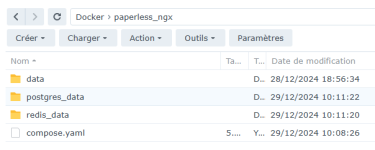hello MilesTEG, j'espère que l'ancien a été sympa dans ses choix de cdx...
Moins drôle...
J'ai créé les 2 dossiers dans Docker avec les sous répertoires.
paperless_ngx ET Paperless-NGX avec leur sous répertoires
j'ai changé le volume3 en volume1 car je n'ai qu'un seul volume
également modifier les codes guid et puid
deux des trois conteners sont verts mais sur le "paperless_ngx_webserser, il précise que media n'existe pas (après contrôle... il est bien dans le bon dossier
Voir la pièce jointe 14253
Certainement d'autres modifs à faire ??
voilà ce que donne le fichier
#
# docker-compose file for running paperless from the Docker Hub.
#
# This file contains everything paperless needs to run.
# Paperless supports amd64, arm and arm64 hardware.
#
# All compose files of paperless configure paperless in the following way:
#
# - Paperless is (re)started on system boot, if it was running before shutdown.
# - Docker volumes for storing data are managed by Docker.
# - Folders for importing and exporting files are created in the same directory
# as this file and mounted to the correct folders inside the container.
# - Paperless listens on port 8010.
#
# In addition to that, this docker-compose file adds the following optional
# configurations:
#
# - Instead of SQLite (default), PostgreSQL is used as the database server.
#
# To install and update paperless with this file, do the following:
#
# - Open portainer Stacks list and click 'Add stack'
# - Paste the contents of this file and assign a name, e.g. 'Paperless'
# - Click 'Deploy the stack' and wait for it to be deployed
# - Open the list of containers, select paperless_webserver_1
# - Click 'Console' and then 'Connect' to open the command line inside the container
# - Run 'python3 manage.py createsuperuser' to create a user
# - Exit the console
#
# For more extensive installation and update instructions, refer to the
# documentation.
# Cr�ation des dossiers :
# mkdir -p /volume3/docker/paperless_ngx/{redis_data,postgres_data,data}
# mkdir -p /volume1/Paperless-NGX/{media,export,consume,trash}
version: "3.4"
services:
broker:
image: docker.io/library/redis:7
container_name: paperless_ngx_redis
restart: unless-stopped
volumes:
- /volume1/Docker/paperless_ngx/redis_data:/data
networks:
paperless_ngx_network:
ipv4_address: 172.27.0.4
labels:
- "com.centurylinklabs.watchtower.enable=true"
db:
image: docker.io/library/postgres:15
container_name: paperless_ngx_postgres
restart: unless-stopped
volumes:
- /volume1/Docker/paperless_ngx/postgres_data:/var/lib/postgresql/data
environment:
POSTGRES_DB: paperless
POSTGRES_USER: paperless
POSTGRES_PASSWORD: paperless
networks:
paperless_ngx_network:
ipv4_address: 172.27.0.3
labels:
- "com.centurylinklabs.watchtower.enable=true"
webserver:
image: ghcr.io/paperless-ngx/paperless-ngx:latest
container_name: paperless_ngx_webserver
restart: unless-stopped
depends_on:
- db
- broker
ports:
- "8010:8000"
healthcheck:
test: ["CMD", "curl", "-fs", "-S", "--max-time", "2", "
http://localhost:8000"]
interval: 30s
timeout: 10s
retries: 5
volumes:
- /volume1/Docker/paperless_ngx/data:/usr/src/paperless/data
- /volume1/Paperless-NGX/media:/usr/src/paperless/media
- /volume1/Paperless-NGX/export:/usr/src/paperless/export
- /volume1/Paperless-NGX/consume:/usr/src/paperless/consume
- /volume1/Paperless-NGX/trash:/usr/src/paperless/trash
environment:
PAPERLESS_REDIS: redis://broker:6379
PAPERLESS_DBHOST: db
# The UID and GID of the user used to run paperless in the container. Set this
# to your UID and GID on the host so that you have write access to the
# consumption directory.
USERMAP_UID: mon code admin PUID
USERMAP_GID: mon code admin GUID
# Additional languages to install for text recognition, separated by a
# whitespace. Note that this is
# different from PAPERLESS_OCR_LANGUAGE (default=eng), which defines the
# language used for OCR.
# The container installs English, German, Italian, Spanish and French by
# default.
# See
https://packages.debian.org/search?keywords=tesseract-ocr-&searchon=names&suite=buster
# for available languages.
#PAPERLESS_OCR_LANGUAGES: tur ces
# Use this variable to set a timezone for the Paperless Docker containers. If not specified, defaults to UTC.
PAPERLESS_TIME_ZONE: Europe/Paris
# The default language to use for OCR. Set this to the language most of your
# documents are written in.
PAPERLESS_OCR_LANGUAGE: fra
PAPERLESS_ADMIN_USER: ${PAPERLESS_ADMIN_USER}
PAPERLESS_ADMIN_PASSWORD: ${PAPERLESS_ADMIN_PASSWORD}
# Check :
https://docs.paperless-ngx.com/configuration/#hosting-and-security
# Paperless uses this to make session tokens. If you expose paperless on the internet, you need to change this, since the default secret is well known.
# Use any sequence of characters. The more, the better. You don't need to remember this. Just face-roll your keyboard.
# Adjust this key if you plan to make paperless available publicly. It should
# be a very long sequence of random characters. You don't need to remember it.
PAPERLESS_SECRET_KEY: ${PAPERLESS_SECRET_KEY}
PAPERLESS_USE_X_FORWARD_HOST: true
PAPERLESS_USE_X_FORWARD_PORT: true
PAPERLESS_URL: ${PAPERLESS_URL}
PAPERLESS_TRUSTED_PROXIES: 192.168.2.209
PAPERLESS_FILENAME_FORMAT: ${PAPERLESS_FILENAME_FORMAT}
PAPERLESS_TRASH_DIR: ${PAPERLESS_TRASH_DIR}
#
https://docs.paperless-ngx.com/configuration/#PAPERLESS_OCR_SKIP_ARCHIVE_FILE
# The default is never.
PAPERLESS_OCR_SKIP_ARCHIVE_FILE: ${PAPERLESS_OCR_SKIP_ARCHIVE_FILE}
#
https://docs.paperless-ngx.com/configuration/#PAPERLESS_TASK_WORKERS
PAPERLESS_TASK_WORKERS: ${PAPERLESS_TASK_WORKERS}
networks:
paperless_ngx_network:
ipv4_address: 172.27.0.2
labels:
- "com.centurylinklabs.watchtower.enable=true"
networks:
paperless_ngx_network:
name: paperless_ngx_network
ipam:
driver: default
config:
- subnet: 172.27.0.0/16
ip_range: 172.27.0.0/24
gateway: 172.27.0.1














